Mazda MX-5 (NB)
| Mazda MX-5 (NB) | |
|---|---|
 | |
| Overview | |
| Manufacturer | Mazda |
| Also called |
Mazda Roadster (Japan) Mazda MX-5 Miata (U.S.) |
| Production | January 1998-2005 |
| Assembly | Hiroshima, Japan (Hiroshima Plant) |
| Designer | Tom Matano (1995)[1][2] |
| Body and chassis | |
| Class | Roadster, sports car (S) |
| Body style |
2-door convertible 2-door coupé[3] |
| Layout | FMR layout |
| Platform | Mazda NB |
| Powertrain | |
| Engine |
1.6 L (98 cu in) B6-ZE I4 (Europe/Japan) 1.8 L (110 cu in) BP-5A I4 (Japan) 1.8 L (110 cu in) BP-4W I4 1.8 L (110 cu in) BP-Z3 I4 1.8 L (110 cu in) turbocharged BPT I4 (Mazdaspeed) |
| Transmission |
5-speed manual 4-speed automatic 6-speed manual |
| Dimensions | |
| Wheelbase | 2,270 mm (89.4 in) |
| Length | 3,940–3,950 mm (155.1–155.5 in) |
| Width | 1,680 mm (66.1 in) |
| Height | 1,220–1,230 mm (48.0–48.4 in) |
| Curb weight | 1,065 kg (2,348 lb) |
| Chronology | |
| Predecessor | Mazda MX-5 (NA) |
| Successor | Mazda MX-5 (NC) |
The Mazda MX-5 (NB) is the second generation of the Mazda MX-5 manufactured from 1998 to 2005.
Overview
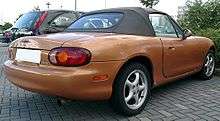
The redesigned MX-5 was previewed at the Tokyo Motor Show in October 1997. In February 1998, Mazda released the second-generation MX-5, production code NB, for the 1999 model year. The NB featured a more powerful engine and external styling cues borrowed from the third generation Mazda RX-7, designed in 1995 by Tom Matano. Prices in the United States, the main market for the MX-5, started at US$19,770.
Although many parts of the interior and body were different, the most notable changes were the headlamps: the first generation's retractable headlamps no longer passed pedestrian safety tests and were replaced by fixed ones. The new car grew slightly in width compared to the earlier model and was slightly more aerodynamic than the original, with a drag coefficient of Cd=0.36. Other notable improvements include a glass rear window with defogger for the convertible top and a retractable wind deflector behind the seats.
The NB continued to employ four-wheel independent suspension, with enlarged anti-roll bars at the front and rear, but the wheels, tires and brakes were significantly upgraded: anti-lock braking system was offered as an option; alloy wheels were now 14" (360 mm) or 15" (380 mm) in diameter and 6" (150 mm) in width, depending on the trim package; sports models were equipped with the larger wheels and 195/50VR15 tires.
The BP-4W engine remained at 1.8 L (110 cu in) but received several minor updates. The engine compression ratio was raised from 9.0:1 to 9.5:1 by adding slightly domed pistons. The intake cam was changed to a solid lifter design with a stronger cam; the intake runners in the head were straightened and the intake manifold was mounted higher up. Mazda's Variable Intake Control System was introduced, which effectively gave a long narrow intake manifold at low rpm for better swirl, changing to a short, free-flowing manifold at high rpm for maximum breathing. Power output of the new engine was quoted at 104.4 kW (140.0 bhp) with 157 N⋅m (116 lbf⋅ft) of torque.
The 1.6 L (98 cu in) B6 engine remained available in Europe and Japan. The base-model 1.8 L (110 cu in) NB could reach 100 km/h (62 mph) in 7.8 s and had a top speed of 210 km/h (130 mph).
MX-5 10th Anniversary Model (1999)
In 1999, Mazda celebrated the 10th anniversary of the MX-5 with the 10th Anniversary Model, a limited edition featuring some until-then exclusive features, namely a 6-speed manual transmission and Bilstein shock absorbers; 15 inch polished aluminum wheels with 195/50R15 tires and a very desirable Torsen limited-slip differential.[4] Performance figures were slightly different, with quicker acceleration and higher top speed than the standard 5-speed model. The model's nickname among owners and enthusiasts was 10AM or 10AE (as in "10th Anniversary Edition"). The car had a unique sapphire blue mica (called innocent blue in Japan) paint colour with two-toned black leather and blue Alcantara seats and floor mats, matching 3-spoke Nardi leather wrapped steering wheel and shift knob, BOSE audio system, bright gauge rings, carbon grained center console panel and stainless steel scuff plates. The addition of the sixth gear resulted in different performance results, with 0–100 km/h (62 mph) in 7.6 seconds, 0.3 seconds faster than the standard 5-speed model, according to Car and Driver, and 0.4 seconds faster according to Motor Trend.[5][6] However, in spite of the 10AM's greater weight, its top rated speed increased from 210 to 214 km/h (130 to 133 mph). Combined fuel consumption improved from 8.5 to 8.0 l/100 km (33 to 35 mpg‑imp; 28 to 29 mpg‑US).
Each car was sequentially numbered on a badge on the driver-side front quarter panel. A "Certificate of Authenticity" with the same number came with each car, signed by Mazda President James E. Miller and dated 10 February 1999. On certain markets, a gift set was also included, consisting of a 1:43 scale diecast model, two Seiko-branded wristwatches (his and hers) with matching blue faceplate and Miata logo, and metal keychain in the form of the Miata logo, all encased in a luxury blue velvet box.[7]
Despite the publicity that Mazda gave to this model, it took more than a year to sell all units, drawing criticism that too many units had been produced (another factor was the high price with an MSRP of $26,875, about $6500 more than a base model). 7,500 units of the 10th Anniversary were produced,[7] with 3,700 distributed to Europe (of which: 600 – UK, 20 – Portugal), 3,150 to North America (of which 3,000 to US and 150 to Canada), 500 to Japan and 150 to Australia, with car number 7,500 being sold in the UK.
For comparison, there were 3,500 units of the NC's 3rd Generation Limited launch model in 2005, and regular limited editions produced each year do not usually exceed 1,500 units per region. The polished aluminum wheels are notorious for corroding once the thin lacquer coating is damaged. Mazda replaced thousands of sets under warranty. There were minor differences in specification according to the market, such as no sports appearance package (front/side/back skirts, rear wing) or air conditioning for Europe.
Facelift (2001)
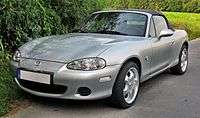
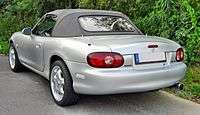
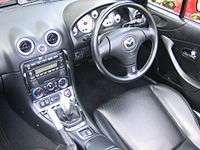
For the 2001 model year, a facelift to the second-generation MX-5 was released. There were some minor exterior changes, with a press-release of July 18, 2000, announcing the changes as "resulting in an even sportier and more forceful look". Fog lamps, previously an option, were made standard. Some cockpit elements were changed, with the instrument panel gauges receiving a white face and red numbers. The seats were also upgraded, incorporating more support in the side bolsters and taller headrests. Added for top models (designated 'Sport' in the U.K) were 16-inch (410 mm) wheels with 205/45VR16 low-profile tires, larger brakes at the front and rear, additional chassis stiffening braces, a limited-slip differential, a 6-speed manual transmission, Bilstein suspension and leather seats. The upgraded tires and suspension allowed the new model to pull 0.91 g in lateral grip in tests by Car and Driver magazine. The body was strengthened, gaining 16% in bending rigidity and 22% in torsional rigidity. With the minimum of options, the 2001 model weighed 1,065 kg (2,348 lb).
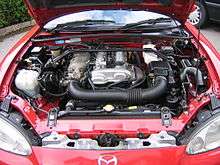
The 1.8 L (110 cu in) BP6D engine was slightly modified and now featured variable valve timing on the intake camshaft. The intake and exhaust system also received a minor upgrade. These modifications resulted in a power output of 113 kW (152 bhp) (Japan, UK and Australia) or 107 kW (143 bhp) (US only). In the United States, Mazda erroneously quoted the power figure for the Japanese and Australian model in early catalogues. Car and Driver magazine and numerous owners confirmed the missing power, and Mazda offered to buy back the 2001 cars due to those misleading power claims. Owners who did not take up the buy back offer were offered an apology and free servicing for the warranty period.
2002 saw the launch of the MX-5 SP. The MX-5 SP was developed and sold in Australia and its turbocharged engine produced 157 kW (211 bhp) at 6,800 rpm. Only 100 of these cars were built. The SP was very expensive in comparison to a standard MX-5 at the time but offered blistering performance. It has fast become a cult classic and sought after model in Australia.
In 2003 Mazda launched a campaign to target a younger group of drivers with the introduction of the Shinsen Version (SV) Miata. The Shinsen (Japanese for "Fresh and New") provided an intermediate step between the base model and the pricier LS. Equipped with most standard features on the LS, such as cruise control and aluminum brush trim. This limited production model also shared an inverted color scheme of the same year Special Edition with a titanium silver exterior and dark blue top and interior.[4]
The 2003 Miata Club Sport (MCS) was a special edition MX-5 NB limited to 50 units (25 soft-tops and 25 hardtops with no soft-tops) at the behest of the SCCA. The MCS was stripped of all interior features such as power windows and air conditioning, with the intent to run on SCCA Solo or SCCA Road Racing events.[4]
Also in 2003, a division of Mazda in Japan released the Roadster Coupé, with a fixed hardtop roof. The body structure was reworked to incorporate the roof and gave a substantial increase in chassis rigidity with a weight increase of 10 kg (22 lb). Production was limited to 179 units for Japan only, making this one of the rarest forms of the MX-5.[3]
Mazdaspeed MX-5 (2004–2005)
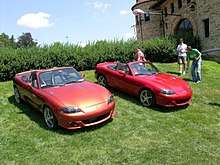
The 2004 model year saw the introduction of the official turbocharged Mazdaspeed MX-5, Roadster Turbo in Japan. It featured an IHI RHF5 VJ35 turbocharger equipped variant of the BP-4W Inline-four engine that produced 133 kW (178 bhp) at 6,000 rpm and 226 N⋅m (167 lbf⋅ft) of torque at 4,500 rpm with a front-mounted air-to-air intercooler.[8] The Mazdaspeed could reach 97 km/h (60 mph) in 6.7 seconds and had a top speed of 204 km/h (127 mph) - limited due to reaching its 6,500 rpm rev limiter [9]. With its upgraded Bilstein shock absorbers and wider tires, the Mazdaspeed model could pull over 0.98 g in lateral grip. Other features included an upgraded 6-speed transmission and clutch assemblies, upgraded drivetrain components, Racing Hart 17" (430 mm) alloy wheels and special interior trim. The 2004 Mazdaspeed MX-5 was only available in Velocity Red Mica and Titanium Gray Metallic for the US-market and Velocity Red Mica for the Canadian-market while the 2005 model was available additionally in Lava Orange Mica and Black Mica in the US-market, with Canada receiving only Titanium Grey Mica. Of the 5,428 Mazdaspeed MX-5s produced for the US Market during model years 2004 and 2005, 4,000 were produced in 2004; the 2005 production run was shortened to only 1,428, due to a fire at the production facility. The other markets are not included in these totals; Canada received only 53 of its allotment. This model was also marketed in Australia as an MX-5 SE without any Mazdaspeed branding (exhaust tip excluded), featured 3.63 diff gears and was available in Sunlight Silver as well as Velocity Red Mica, Titanium Gray Metallic and Black Mica for 2005. It was also slightly de-tuned with only 121 kW (162 bhp). Boost pressure was 7.25 psi (0.5 bar) for the Australian model vs 8.5 psi (0.6 bar) of the North American and Japanese models, explaining the power difference. The MX-5 SE has been used for both gravel and tarmac rallying in Australia, showing the versatility of these cars in racing.
Safety
The Euro NCAP Safety Ratings for MX-5s manufactured in 2002 were given 4 out of 5 stars for adult protection but only 1 out of 4 stars for pedestrian protection. EuroNCAP stated: "This is a poor performance despite the MX-5 benefiting from not having to have the leading edge of its bonnet tested because of its low profile."
In media
The Mazda MX-5 NB was used as one the hero cars in the 1998 TV series V.I.P.[11]
Technical specifications (UK)
| Drivetrain specifications by generation (UK market)[7] | ||||||||
|---|---|---|---|---|---|---|---|---|
| Model year(s) | Model no(s). | Chassis code(s) | Engine type | Engine code | Transmission(s) | Power@rpm | Torque@rpm | |
| 1998–2001 | 1.6i | NB | 1.6 L inline-4 | B6-ZE | 5-speed MT | 81 kW (108 bhp) @6,500 | 134 N⋅m (99 ft⋅lbf) @5,000 | |
| 1998–2001 | 1.8i | NB | 1.8 L inline-4 | BP-4W | 5 or 6-speed MT | 100 kW (140 bhp) @ 6,500 | 161 N⋅m (119 ft⋅lbf) @ 5,000 | |
| 2001–2005 | 1.6i | NB | 1.6 L inline-4 | B6-ZE | 5-speed MT | 82 kW (110 bhp) @ 6,500 | 134 N⋅m (99 ft⋅lbf) @ 5,000 | |
| 2001–2005 | 1.8i | NB | 1.8 L inline-4 | BP-Z3 | 5 or 6-speed MT | 109 kW (146 bhp) @ 6,500 | 168 N⋅m (124 ft⋅lbf) @ 5,000 | |
Awards and recognition
- Car and Driver's 10Best list from 1998-1999 and 2001[12]
References
- ↑ "An interview with Tsutomu Tom Matano". 1998-06-16. Retrieved 2014-12-27.
- ↑ "Tom Matano on LinkedIn". Retrieved 2014-12-27.
- 1 2 "Mazda Roadster Coupe (NB8C series)". Retrieved 2014-12-27.
- 1 2 3 Okulski, Travis (2015-01-30). "Your Guide To Every Special Edition Mazda Miata Ever Sold In America". Jalopnik. Retrieved 2018-10-04.
- ↑ Gregory, Fred (September 1999). "Mazda MX-5 Miata 10th-Anniversary Edition – Short Take Road Test". Car and Driver. Retrieved 2014-09-09.
- ↑ Stone, Matt (June 1999). "2000 Mazda Miata 10th Anniversary Edition". Motor Trend. Retrieved 2014-09-09.
- 1 2 3 You and Your MX5/Miata, Liz Turner 2002, Haynes Publishing, ISBN 1-85960-847-7.
- ↑ "2004 Mazda Mazdaspeed MX-5 Miata Turbo US". carfolio.com. February 28, 2013. Retrieved July 27, 2018.
- ↑ "Mazdaspeed MX 5 Miata road test". caranddriver.com. Retrieved 2018-06-12.
- ↑ "Euro NCAP results for Mazda MX-5". euroncap.com. 2002.
- ↑ Stentz, Zack (1999-10-04). "Pamela Lee sports new curves on her syndicated hit V.I.P.". Entertainment Weekly. Retrieved 2018-10-03.
- ↑ "Mazda MX-5 Miata - 10Best Cars". Car and Driver. Retrieved 2018-05-27.
External links
| Wikimedia Commons has media related to |
Mazda automobile timeline, North American market, 1980s–present | |||||||||||||||||||||||||||||||||||||||
|---|---|---|---|---|---|---|---|---|---|---|---|---|---|---|---|---|---|---|---|---|---|---|---|---|---|---|---|---|---|---|---|---|---|---|---|---|---|---|---|
| Type | 1980s | 1990s | 2000s | 2010s | |||||||||||||||||||||||||||||||||||
| Model year | 0 | 1 | 2 | 3 | 4 | 5 | 6 | 7 | 8 | 9 | 0 | 1 | 2 | 3 | 4 | 5 | 6 | 7 | 8 | 9 | 0 | 1 | 2 | 3 | 4 | 5 | 6 | 7 | 8 | 9 | 0 | 1 | 2 | 3 | 4 | 5 | 6 | 7 | 8 |
| Subcompact | GLC | GLC | Mazda2 | ||||||||||||||||||||||||||||||||||||
| 323 | 323/Protegé | ||||||||||||||||||||||||||||||||||||||
| Compact | Protegé | Protegé | Mazda3 | Mazda3 | Mazda3 | ||||||||||||||||||||||||||||||||||
| 626 | 626 | 626 | |||||||||||||||||||||||||||||||||||||
| Mid-size | 626 | 626 | Mazda6 | Mazda6 | Mazda6 | ||||||||||||||||||||||||||||||||||
| Millenia | |||||||||||||||||||||||||||||||||||||||
| Full-size | 929 | 929 | |||||||||||||||||||||||||||||||||||||
| Sport compact | MX-3 | ||||||||||||||||||||||||||||||||||||||
| MX-6 | MX-6 | ||||||||||||||||||||||||||||||||||||||
| Sports | MX-5 Miata | MX-5 Miata | MX-5 Miata | MX-5 | |||||||||||||||||||||||||||||||||||
| RX-7 | RX-7 | RX-7 | RX-8 | ||||||||||||||||||||||||||||||||||||
| Minivan | Mazda5 | Mazda5* | |||||||||||||||||||||||||||||||||||||
| MPV | MPV | ||||||||||||||||||||||||||||||||||||||
| Subcompact crossover | CX-3 | ||||||||||||||||||||||||||||||||||||||
| Compact crossover/SUV | Navajo | Tribute | Tribute | CX-5 | CX-5 | ||||||||||||||||||||||||||||||||||
| Mid-size crossover | CX-7 | ||||||||||||||||||||||||||||||||||||||
| Full-size crossover | CX-9 | CX-9 | |||||||||||||||||||||||||||||||||||||
| Pickup | B-Series | B-Series | B-Series | B-Series | |||||||||||||||||||||||||||||||||||
| * Mazda5 only available in Canada since 2015 | |||||||||||||||||||||||||||||||||||||||